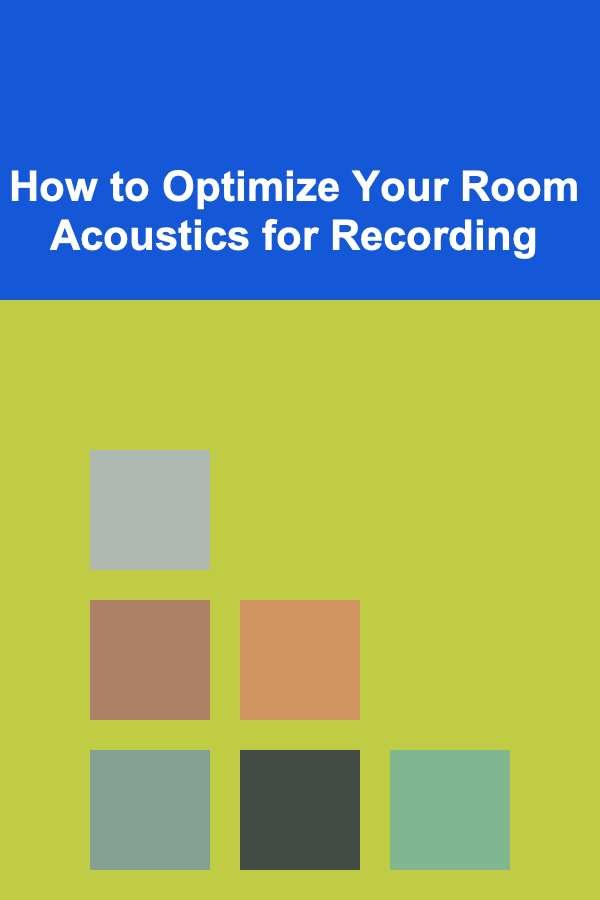
How to Optimize Your Room Acoustics for Recording
ebook include PDF & Audio bundle (Micro Guide)
$12.99$7.99
Limited Time Offer! Order within the next:

When it comes to recording music, podcasts, or voiceovers, the environment in which you record plays a critical role in the quality of the final product. A room's acoustics can either enhance the recording process or introduce unwanted noise, echoes, and distortion. Understanding how to optimize room acoustics for recording can significantly improve the clarity, depth, and overall quality of your audio recordings.
In this guide, we will walk through the fundamental concepts of room acoustics, how sound behaves within a space, and practical steps to optimize your room for recording. Whether you're a home studio enthusiast, a podcast creator, or a music producer, this article will provide you with valuable insights into improving your recording environment.
Understanding Room Acoustics
What Are Room Acoustics?
Room acoustics refer to how sound behaves in a particular space, influenced by factors such as the size, shape, materials, and layout of the room. Every room, regardless of size, affects sound in unique ways. When sound waves interact with the walls, floor, ceiling, and other surfaces, they can be absorbed, reflected, refracted, or diffused. The way these interactions occur will determine the quality of your recordings.
Key acoustic concepts to understand include:
- Reverberation: The persistence of sound in a room after the source has stopped. This is typically caused by sound waves reflecting off walls, ceilings, and other surfaces.
- Standing Waves: Occur when sound waves bounce between parallel surfaces, causing some frequencies to be reinforced and others canceled out.
- Reflection: Sound bouncing off surfaces, causing unwanted echoes.
- Absorption: Materials in a room that absorb sound waves, reducing reflections and reverberation.
- Diffusion: Scattering of sound waves, preventing harsh reflections and creating a more even distribution of sound in the room.
The Impact of Acoustics on Recording
Poor acoustics can result in recordings that sound unnatural, hollow, or muddled. For example, if your room has too much reverberation, your voice or instrument may sound distant and unclear. Similarly, if the room has excessive standing waves, certain frequencies may be too pronounced, distorting the recording. Therefore, optimizing acoustics ensures that your recordings are clean, balanced, and as true to the source as possible.
Assessing Your Room's Acoustics
Before diving into solutions, it's essential to evaluate your room's current acoustic conditions. Understanding the problem areas will allow you to address them effectively.
1. Listen to Your Room
Start by listening carefully to how sound behaves in the room. You can do this by clapping your hands or making a loud sound and paying attention to the following:
- Echoes and Reverberation: Do you hear the sound bouncing back at you after a brief delay?
- Boominess: Is there an excessive emphasis on low-frequency sounds (bass) that muddles your recordings?
- Dead Spots: Are there areas where the sound seems unusually quiet or distant?
These simple tests will give you an initial sense of the room's acoustic characteristics. Pay attention to where you record in the room and notice how the sound changes in different positions.
2. Room Dimensions and Shape
The shape and size of your room can impact how sound waves interact with it. For instance:
- Square or rectangular rooms are prone to standing waves due to parallel walls, which can cause certain frequencies to build up or cancel out.
- High-ceiling rooms can cause more pronounced reverberation, making the room feel "live" or echoey.
- Irregularly shaped rooms can sometimes help mitigate standing waves, but they can also introduce unpredictable reflections.
Use your room dimensions as a starting point to assess possible acoustic challenges.
Optimizing Room Acoustics: Practical Steps
Now that you've assessed your room's acoustics, let's explore the best ways to optimize your space for recording.
1. Acoustic Treatment: Absorption
Absorptive materials are critical for reducing unwanted reflections, reverberation, and echo. These materials absorb sound waves rather than letting them bounce back into the room.
Materials for Absorption
- Acoustic Foam Panels: These are one of the most common solutions. They come in various shapes and sizes (e.g., wedges, pyramids, and egg crates) and can be mounted on walls to absorb mid and high frequencies. However, foam alone may not be enough for low frequencies.
- Bass Traps: For low-frequency absorption, bass traps are specifically designed to absorb low-end energy, which tends to accumulate in corners. Place them in room corners where sound tends to build up.
- Heavy Curtains: Thick curtains or drapes can be hung on windows and even walls to help absorb sound. This is a budget-friendly option but may not be as effective as dedicated acoustic foam or bass traps.
- Carpet and Rugs: Hard floors, such as wood or tile, reflect sound, which can cause clarity issues. Covering floors with thick carpets or rugs will help reduce reflections from the ground.
Placement of Absorptive Materials
- First Reflection Points: These are the points where sound waves first reflect off surfaces and reach your ears after the direct sound from your source. These points should be treated with absorption materials. You can find these areas by using the mirror trick: sit in your recording position and have someone move a mirror along the walls until you see your monitor or microphone. Place absorptive materials at these points.
- Corners: Bass traps should be placed in the corners of the room, as this is where low-frequency buildup often occurs.
- Ceiling and Floor: If you have a reflective ceiling or hard floor, consider placing absorbent materials above and below your recording setup.
2. Acoustic Treatment: Diffusion
While absorption helps reduce unwanted sound reflections, diffusion scatters sound waves evenly throughout the room, preventing a "dead" or overly dampened sound. Diffusion helps maintain a sense of space and clarity.
Materials for Diffusion
- Diffuser Panels: Diffusers come in many shapes, such as pyramids, grids, or curved surfaces. They scatter sound waves, helping to preserve room liveliness without causing unwanted echoes.
- Bookshelves and Furniture: Strategically placed furniture, such as bookshelves filled with irregularly shaped items, can naturally diffuse sound. The irregular surfaces break up sound waves and scatter them in different directions.
Placement of Diffusive Materials
-
Place diffusers along walls where reflections are likely to occur but where absorption might deaden the room too much. Focus on the back wall, the sidewalls, and the ceiling if you have an open, high ceiling.
-
In small rooms, diffusing the first reflection points is especially important to avoid a "boxy" sound.
3. Room Positioning: Where You Record Matters
The position of your microphone and speakers (in the case of monitoring) plays a huge role in optimizing room acoustics.
- Avoid Recording in the Center: Recording at the center of the room can result in standing waves and uneven sound reflection. Try to position yourself or your microphone off-center.
- Monitor Speaker Placement: If you're using speakers for monitoring, position them symmetrically and at an equal distance from the walls to ensure balanced sound. The ideal position for monitors is typically in an equilateral triangle with your listening position.
4. Room Isolation
In some cases, you might want to consider sound isolation to prevent external noise from interfering with your recording. Here are some isolation tips:
- Seal Gaps and Windows: Make sure all doors and windows are sealed tightly to prevent external noise from entering. You can use weather stripping to close gaps around windows and doors.
- Isolation Pads for Microphones: Isolation pads or shock mounts can prevent vibrations from traveling through the microphone stand into the recording.
- Acoustic Booths: For critical recording situations, you might consider an isolation booth or a portable vocal booth to further isolate your sound from external interference.
Additional Tips for Recording in an Optimized Room
- Monitor Your Room's Frequency Response: Use measurement microphones and software (like Room EQ Wizard) to analyze the room's frequency response. This will show you how specific frequencies behave in the room and help you identify issues.
- Use a Subwoofer: If you're monitoring low-end frequencies, ensure your subwoofer is placed optimally. Placing it near walls can cause unwanted bass buildup, so experiment with its positioning.
- Room Calibration: For more advanced users, room calibration tools can adjust your sound system or speakers to compensate for the room's acoustic anomalies.
- Be Mindful of the Time of Day: External noise, such as traffic or HVAC systems, can affect your recording quality. Record at quieter times of the day to avoid these disturbances.
Conclusion
Optimizing your room acoustics is one of the most impactful steps you can take to improve your recording quality. Whether you are a beginner or a seasoned professional, understanding how sound behaves in your space and applying the right acoustic treatments will help you create clearer, more professional recordings. By carefully considering elements like absorption, diffusion, and positioning, you can transform your room into a space that enhances your recording process rather than hinders it.
Taking the time to optimize your room acoustics is an investment that will pay off in better audio, reduced post-production work, and a more enjoyable recording experience overall.
Reading More From Our Other Websites
- [Personal Investment 101] How to Monetize Your Deep Learning Skills as a Freelancer
- [Home Soundproofing 101] How to Soundproof a Child's Room for Quieter Play
- [Weaving Tip 101] Best Natural Fiber Weaving: A Guide to Wool, Linen, Silk, and Beyond
- [Ziplining Tip 101] From Dawn to Dusk: Experiencing the Magic of a Lakeside Zipline
- [Organization Tip 101] How to Tackle Digital Clutter on Your Devices
- [Sewing Tip 101] Sewing Jargon Explained: From 'Notions' to 'Selvedge'
- [Personal Care Tips 101] How to Create Bold, Defined Eyebrows Using Brow Gel and Pencil
- [Home Space Saving 101] How to Maximize Space in Tiny Bathrooms with Storage Hacks
- [Scrapbooking Tip 101] Affordable DIY Embellishments: Crafting Your Own Scrapbooking Accents
- [Home Budget 101] How to Budget for Home Repairs and Unexpected Expenses

How to Budget for Travel Without Compromising Your Financial Goals
Read More
How to Organize and Store Holiday Decorations Efficiently for Next Year
Read More
How to Stage Your Home on a Budget
Read More
How to Stay Compliant with Local Laws When Renting on Airbnb
Read More
Mastering the 20/20 Rule for Decluttering: A Comprehensive Guide
Read More
10 Tips for Keeping Music Lessons Fun and Motivating
Read MoreOther Products

How to Budget for Travel Without Compromising Your Financial Goals
Read More
How to Organize and Store Holiday Decorations Efficiently for Next Year
Read More
How to Stage Your Home on a Budget
Read More
How to Stay Compliant with Local Laws When Renting on Airbnb
Read More
Mastering the 20/20 Rule for Decluttering: A Comprehensive Guide
Read More